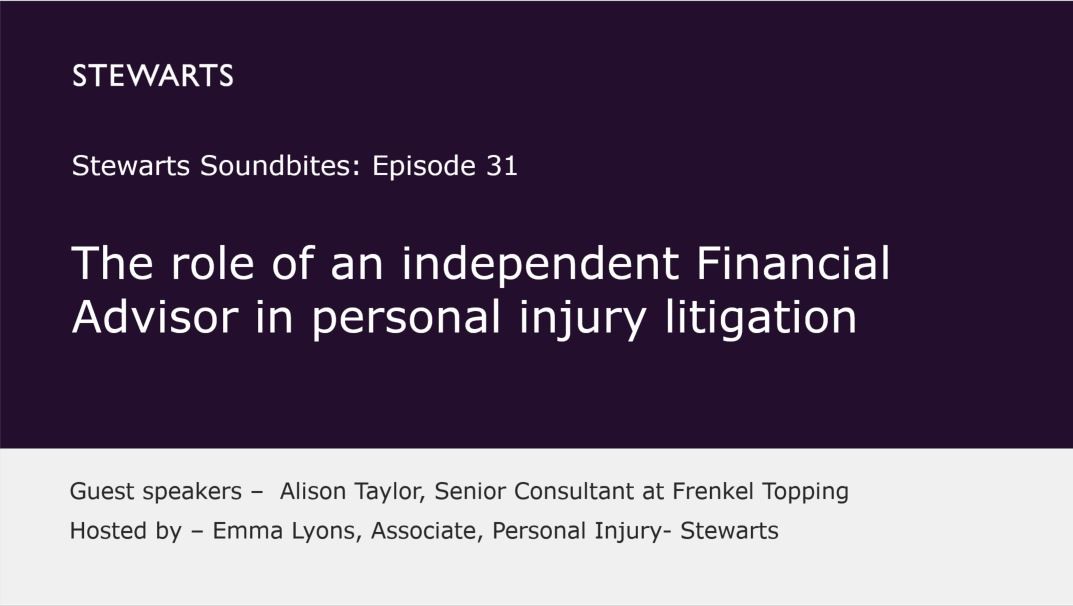Andrew Dinsmore and Clare Salmon, Personal Injury partners, acted for the claimant in PAL (a child by her mother and litigation friend COL) v Davison & ors [2021] EWHC 1108 (QB). In this article Andrew and Lucie Clinch consider the court’s approach to the claimant’s interim payment application.
Background
The claimant was walking along a pavement with her family when a vehicle mounted the curb and struck her, causing serious injuries, including a serious brain injury. Initial evidence is that it is unlikely a definitive prognosis as to her injuries will be possible before the fifth anniversary of the accident, when she will be 17.
Following the accident, the claimant was discharged from hospital but was unable to return to her three bedroom end of terrace family home. An alternative rental property was found at short notice, but was never considered a viable long-term option for her complex needs. In addition, the tenancy on her current property was due to expire within the next 12 months at the time of the application.
The first defendant was the driver of the vehicle, the second defendant owned and operated the vehicle he was driving, and the third defendant is the insurer. The first defendant had not responded to the claim, and judgment was entered against him. The second and third defendants are jointly represented; the third defendant insurer accepts liability to meet the claim.
The defendants were aware that the claimant’s tenancy would expire in April 2022 and acknowledged that the rental property was unsuitable for the claimant. However, the sum of £2m claimed to purchase the required property was disputed.
The claimant had previously received £1m in interim payments in order to fund her ongoing care, case management therapy and equipment needs. Given the urgency and the lack of viable alternative properties on the market, and the need to have the interim payment approved by the court in any event, Stewarts made an urgent application for a £2m interim payment for accommodation, so that the claimant could purchase a property suitable for her ongoing needs.
A professional deputy had been appointed by the Court of Protection to manage the claimant’s financial affairs. The professional deputy had applied to the Court of Protection for an order authorising them to purchase a property. However, that application was rejected on the basis that, at the time, a suitable property had not been identified.
It was understood by the professional deputy and the claimant’s legal team that full time High Court judges do have inherent jurisdiction as Court of Protection judges. Therefore, Stewarts invited the High Court judge to exercise that jurisdiction and vary the Court of Protection order at the same time as ordering the interim payment. This would enable the deputy to purchase the property without the need to seek approval in advance from the Court of Protection.
Prior to the interim payment hearing, the professional deputy also made an urgent application to the Court of Protection seeking to vary the order to enable the purchase of the property identified by the claimant.
Suitable property and the property market – the evidence
Expert evidence for the claimant demonstrated that there was only one potential property available in the area in which her mother was content to move that could accommodate the claimant’s long-term needs. This property would need adaptations to suit those needs.
This property was marketed at £1,250,000, although it was believed that an offer of £1,190,000 would be accepted. The expert opinion was that the property could be adapted and extended to suit, which would cost up to £612,000.
The defendants provided desktop expert evidence as to what properties might be available in the area. These were limited to three. Of the three properties, two were marketed at around £960,000 and would require adaptations costing around £490,000. However, by the time of the hearing, these two properties had been sold.
Only one potential property was available, and this was outside the claimant’s mother’s desired locality. The area where the claimant’s mother wanted to live was one with high demand, and suitable properties were difficult to find. The judge acknowledged that the claimant’s mother had cogent reasons to not move out of the area as proposed by the defendants.
The claimant sought £2m, compared to the defendant’s offer of £1.25m.
The court’s approach – Eeles v Cobham Services
The case of Eeles v Cobham Services [2009] EWCA Civ 204 summarises the approach a judge should take when considering whether to award an interim payment in a personal injury claim. Eeles confirms that the judge should generally avoid ordering a sum that might fetter the trial judge’s discretion to allocate damages, including on periodical payment orders.
Mrs Justice Yip applied the two stages of Eeles as follows:
Stage 1
Eeles stage 1 confirms that the judge dealing with the interim payment application must assess the likely amount of the final judgment, leaving out of account the heads of future loss the trial judge might wish to deal with by a periodical payment order (ie. care and case management). Mrs Justice Yip said the starting point is that ‘the assessment should only comprise special damages “to date” for pain, suffering and loss of amenity, with interest on both’.
As per Eeles, it will usually be appropriate to include accommodation costs in the expected capital award. Mrs Justice Yip said it should ‘not be too difficult to assess the capitalised accommodation costs’ at the first stage, but stressed that it is essential to keep in mind the clear principles underpinning stage 1 of Eeles. In attempting to estimate the likely amount of the lump sum element of the final judgment, she must avoid the risk of overpayment but not keep the claimant out of his or her money.
In assessing the likely award for pain, suffering and loss of amenity (PSLA), past loss and accommodation, the court may award a reasonable proportion of that amount. Mrs Justice Yip acknowledged that she should not embark on a ‘mini-trial’ as there was little dispute between the parties about the need for accommodation, and only its cost.
We argued that the interim payment would be no more than a reasonable proportion of the final lump sum that the court may award for general damages, past loss to trial and future accommodation.
There is conflicting case law and argument about whether past losses ‘to date’ under Eeles was intended to be interpreted as meaning up to the date of the application or up to the date of trial. Justice Yip elected to calculate losses for the purposes of her Eeles assessment to the date of our application.
By excluding the accommodation sum from stage 1, the claimant would not be restricted in relation to later interim payments, which she will need for items such as care and case management expenses prior to trial (particularly given her young age and the early stages of her rehabilitation). Mrs Justice Yip saw no reason why the parties should not be able to strike such a balance and reach agreement on other heads of loss / special damages in the future, without the need for applications for interim payments.
Mrs Justice Yip was minded that any testing of the expert evidence will be undertaken at trial, and there was a possibility that the defendant expert evidence might be preferred. Accordingly, she found that £2m was not a reasonable sum for a property by a conservative assessment of the relevant heads of loss (applying stage 1).
Stewarts felt it was clear from the evidence provided in support of the interim payment application that there as a real, reasonable and immediate need for funds for a property purchase now, and that the application would succeed under stage 2.
Stage 2
The assessment under stage 2 would only arise / be applied where there is a real or urgent need for funds. Stage 2 of Eeles outlines when a judge will be entitled to include the likely amount of any final judgment. The interim judge will need to be able to predict confidently that the trial judge might award a larger capital sum than that covered by general and special damages and accommodation costs alone. In addition, there must be a real need for the interim payment.
When considering a request for an interim payment for accommodation, the judge considering the application must be satisfied that there is a real need for the accommodation now, rather than after the trial.
Unlike in the Eeles case, where the claimant was housed, and there was unlikely to be a move before trial, our client had a real need for accommodation now. Mrs Justice Yip held that it was more than reasonably required and, in fact, ‘essential’ that accommodation was found urgently. The evidence was sufficient to conclude that there was a real, reasonable and immediate need for the interim payment for the purpose it had been requested.
The claimant’s evidence was clear that a property search since the claimant’s discharge from hospital in August 2020 had shown no alternative rental options. Also, there was insecurity, as her current property was due to be returned to the owner for his own family within the next year.
Mrs Justice Yip made no finding on whether the potential property on offer was suitable, as she was not required to do so for the purposes of the Eeles assessment. She was, however, satisfied that the sum of £2m sought by the claimant was reasonably required and would cover the purchase, ancillary costs, adaptations and relocation costs of the only available property. She also found that there ought to be some surplus for aids and equipment.
She was confident that in awarding the interim payment at this level, the trial judge’s freedom to allocate future loss would not be fettered. Therefore, the application for £2m succeeded at stage 2.
Proceedings in the Court of Protection
Full-time High Court judges can exercise discretion over the Court of Protection and vary a deputy’s appointment to allow a property to be purchased. However, Mrs Justice Yip did not consider she should do so and did not invoke that jurisdiction. She said she hoped that in ordering the interim payment, the Court of Protection would now authorise the property purchase.
Mrs Justice Yip preferred to leave authorisation and purchase of a suitable property to the Court of Protection in the absence of the full file and all relevant information.
Postscript
Further to her reasoned judgment, Mrs Justice Yip (while keen to maintain separate function from the Court of Protection) stated that she would attempt to assist with expediting the approval from the Court of Protection. As the Court of Protection faces severe delays, Stewarts contacted Mrs Justice Yip after the hearing for such assistance. She made a further order directing that the Court of Protection be invited to expedite the claimant’s application and determine it as soon as reasonably practicable. This order has been provided to the Court of Protection for its urgent attention.
Key takeaways
The case confirms that while High Court judges can exercise dual jurisdiction in relation to the Court of Protection, the facts of the case may determine that the decisions of judges within the Queen’s Bench Division may continue to remain separate to those of the Court of Protection, even in an urgent scenario like this.
The following practice points are also worth noting:
- Evidence is key. Stewarts had already been providing rolling disclosure to the defendants as to care, case management and therapy needs further to a court order, and the defendants were aware of the claimant’s ongoing needs. In obtaining early expert accommodation evidence, Stewarts could present to the court, with some degree of certainty, that there was a lack of viable property options for the claimant in her locality. That choice was limited to one by the time of the hearing.
- Act with urgency. Stewarts’ proactivity in making the urgent application when it became clear the claimant was at a real risk of becoming homeless within the next year was paramount. Our ability to also respond quickly to the defendant’s rebuttal evidence on accommodation was also important.
- Timing is relevant. In child cases, where the trial is some time away, and there is uncertainty about what is required now and in the future, it is more difficult for the court to aggregate past losses to trial for special damages, such as rehabilitation. However, in applications made closer to trial it might be easier to secure payments under Eeles stage 1, particularly for an adult claimant with capacity.
Our work is ongoing in seeking the Court of Protection’s urgent approval to purchase the property.
Click here to access the full PI Focus, July 2021 Volume 31 Issue 6 online.
Lucie’s and Andrew’s article is on page 20.
You can find further information regarding our expertise, experience and team on our Personal Injury pages.
If you require assistance from our team, please contact us or alternatively request a call back from one of our lawyers by submitting this form.
Subscribe – In order to receive our news straight to your inbox, subscribe here. Our newsletters are sent no more than once a month.








